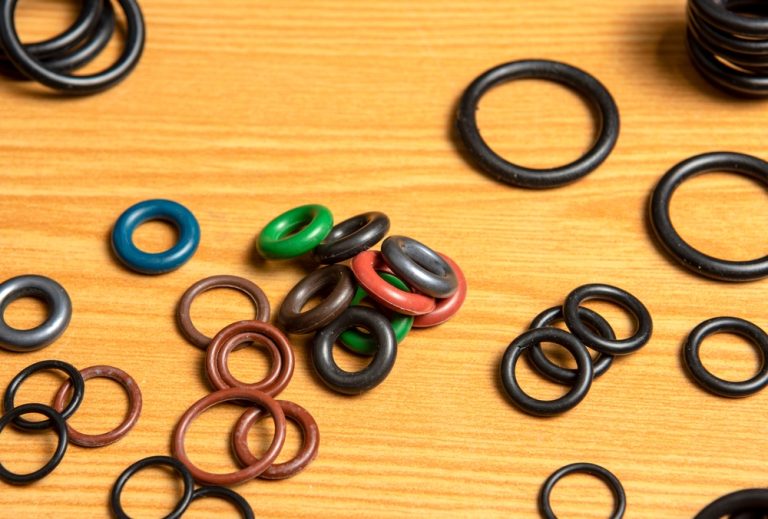O-rings come in many sizes, depending on their application. The smallest commercially available ones are less than a millimeter across for an inside diameter and are for medical laboratories. The largest fit on solid rocket boosters like those on the massive SLS that NASA plans to launch humans to the Moon and Mars with.
Take a look at our O-rings sizing guide to help determine what you need for your machines or heavy equipment.
How are O-rings measured?
When figuring out what size of an O-ring you need, you must look at three measurements.
- Inside diameter, measured from one inner border to the other when laying flat.
- Outside diameter, from the outer border to the other side.
- Cross-sectional thickness, measured from one side of the material to the other. Thicknesses range from 1.02 millimeters to 6.99 millimeters.
Calipers can measure the thickness, while a ruler generally works for the diameters. However, there are plenty of digital devices, including high-definition cameras using the right software, that can take precise and accurate measurements for sizing O-rings.
You can also match measurements with a laminated size chart or use a molded sizing cone that some manufacturers provide. Pi-tape also works, as does a specialized O-ring sizer.
How do manufacturers standardize sizes for O-rings?
SAE International publishes its AS568D Aerospace Size Standard for O-Rings, which much of the American market follows. These standards work for automobiles, heavy equipment, jet engines, industrial equipment, and military-grade equipment for 369 standard sizes in six different series.
Metric sizes are defined by the ISO 3601-1:2002 standard, grouped into general-purpose O-rings and aerospace O-rings. ISO identifies 828 total standard sizes, 445 for general and 383 for aerospace.
Any O-ring manufacturer should be able to create any of the standard sizes listed by both of these organizations.
Why must O-rings fit properly?
O-rings that are too small may break due to tolerances being too tight. O-rings that are too large may cause leaks because they don’t seal properly.
If you’re worried about proper sealing, that’s where O-ring coatings can help improve your tolerances and make O-rings last longer.
How do I choose the right cross-sectional thickness for O-rings?
In general, O-rings with a larger cross-sectional thickness (you may also see this as a cross-sectional diameter) usually display better resistance to compression. They’ll also have less volume swell in fluids. If an O-ring is scratched, it will have less propensity to leak if the surface is scratched. These are all due to more material in the O-rings. Larger thicknesses resist rolling in a groove but have more friction.
O-rings with smaller cross-sectional thickness improve physical properties, require less space to fit, and resist explosive decompression, which is why you’ll find smaller cross-sectional thicknesses in aerospace and underwater applications. A small cross-sectional thickness for O-rings has less friction but tends to roll and slide in a groove due to the tugging forces along the inside edge.
It is possible to have a cross-sectional thickness that is greater than the inside diameter of an O-ring. The larger the diameter gets, the less likely you’ll find an O-ring with a greater cross-sectional thickness.
Coatings can help improve tolerances and extend the longevity and functionality of O-rings, giving your staff the perfect fit for your machinery.
What about O-ring flash?
You’ll see O-ring flash, usually on the inner and outer surfaces. The maximum amount of O-ring flash should be no more than 0.13 millimeters thick and 0.08 millimeters of protrusion transversely from the main surface. Anything more than this can affect the performance and tolerance of your O-ring.
How do I properly measure an O-ring?
- Place the O-ring on a clean, flat, and level surface. That way, it doesn’t bend or distort the diameter.
- Use your measuring tool to measure the inside and outside diameters.
- A vernier caliper is an accurate way to measure the cross-sectional thickness. Lightly clamp the jaws of the caliper without squeezing too much. Otherwise, you will compress the O-ring and get an incorrect size.
How can coatings improve the sizing of O-rings?
Coatings that reduce the coefficient of friction and improve tolerances can give you more accurate and precise measurements when you need a perfect fit. More accurate fittings can improve the performance of the O-rings while improving longevity.
Who can supply me with O-ring coatings?
EZ Coating can deliver O-ring coatings that beat PTFE (Teflon) in several important factors, like the coefficient of friction and abrasion resistance, for your industrial equipment, heavy machinery, and manufacturing equipment. We can formulate a coating to suit your exact specifications while helping you improve your sizing.
Contact us for more information or if you need a test sample.

